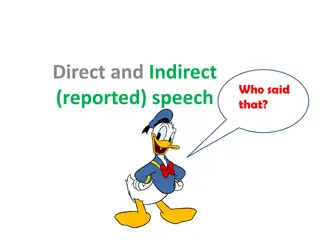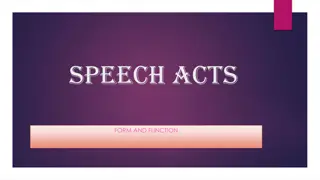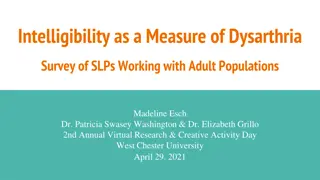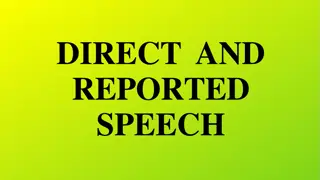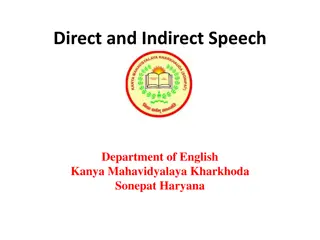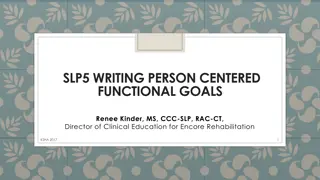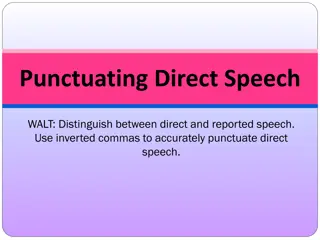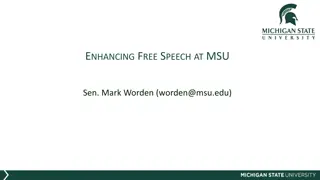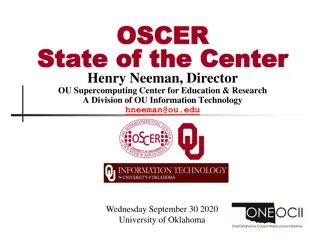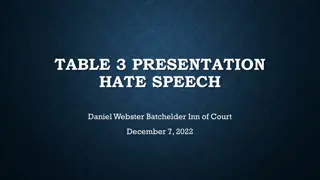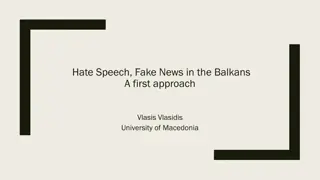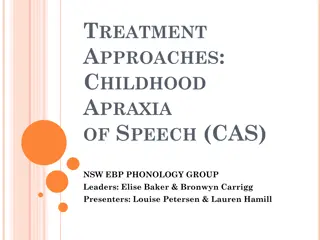Group Speech Symposium: Effective Presentation Strategies
A symposium-style speech assignment where groups of 3-5 participants explore diverse angles of a chosen topic. Learn to collaborate, deliver organized speeches, and engage with the audience effectively. Choose from suggested topics or create your own. Develop outlines, practice speeches, and enhance public speaking skills. Embrace the art of group presentations and witness the power of collective knowledge dissemination through structured discussions.
Download Presentation

Please find below an Image/Link to download the presentation.
The content on the website is provided AS IS for your information and personal use only. It may not be sold, licensed, or shared on other websites without obtaining consent from the author.If you encounter any issues during the download, it is possible that the publisher has removed the file from their server.
You are allowed to download the files provided on this website for personal or commercial use, subject to the condition that they are used lawfully. All files are the property of their respective owners.
The content on the website is provided AS IS for your information and personal use only. It may not be sold, licensed, or shared on other websites without obtaining consent from the author.
E N D
Presentation Transcript
Sept. 2024 doc.: IEEE 802.11-24/1520r0 Charging and Discharging Intervals in Passive AMP STAs Date: 2024-09-05 Authors: Name Dror Regev Yaron Ben-Arie Shimi Shilo Rani Keren Affiliations Address Huawei Huawei Huawei Huawei Phone email dror.regev@huawei.com yaron.benarie@huawei.com shimi.shilo@huawei.com rani.keren@huawei.com Submission Slide 1 Dror Regev, Huawei
Sept. 2024 doc.: IEEE 802.11-24/1520r0 Abstract An AMP STA that harvests ambient RF may be able to charge and store energy on a capacitor to a voltage that enables RX+TX operation of the STA before the voltage drops and the STA goes into idle mode to re-charge the capacitor. The parameters involved in maximum RX+TX operation duration, STA re-charging and initial charging are investigated. Submission Slide 2 Dror Regev, Huawei
Sept. 2024 doc.: IEEE 802.11-24/1520r0 Background: Passive Tag Analog Front-End https://ieeexplore.ieee.org/stamp/stamp.jsp?tp=&arnumber=6376990 Signals: POR Power On Reset . Reset the logic of the tag BS Back Scattering enable Srx Detected RX signal Stx TX modulation signal fosc On-chip oscillator generated frequency https://ieeexplore.ieee.org/stamp/stamp.jsp?tp=&arnumber=6740091 Vdd Submission Slide 3 Dror Regev, Huawei
Sept. 2024 doc.: IEEE 802.11-24/1520r0 Energizer to STA WPT Losses Accurate energizing power received Pr at each STA antenna depends on multiple parameters. Antenna gain is a trade-off. PT - Power transmitted Pr - Power received AP WPT Loss Factors: Distance Frequency Antennas Gain Tag orientation Shadowing Object Absorption Higher than 20 dBm PT energizer EIRP transmitted levels such as 27, 30 or 36 dBm are potentially available Can the energizer deliver enough power to all STAs? Pr3 Pr2 Pr1 Friis simplified WPT energizing loss: WPTloss = 20log10( ) 20log10(4 d) Distance 2.4 GHz Loss Loss 0.9 GHz PT 2.4/0.9 GHz dBm Pr 2.4/0.9 GHz dBm 1 m 40 dB 31.5 dB 20 -20/-11.5 2 m 46 dB 37.5 dB 20 -26/-17.5 PT 4 m 52 dB 43.5 dB 20 -32/-23.5 Antenna Gain trade-off: Reduced loss vs. reduced spatial coverage. Energizer 5 m 54 dB 45.5 dB 20 -34/-25.5 10 m 60 dB 51.5 dB 20 -40/-31.5 WPT Energizing Loss @ 900 MHz is lower. Submission Slide 4 Dror Regev, Huawei
Sept. 2024 doc.: IEEE 802.11-24/1520r0 STA Power Charging / Discharging Timing Profile Voltage measured on chip Vdd STA harvests energy from 0 volts to Vmin. Then the voltage is sufficient to power-on reset some digital circuits, bias a reference voltage for level measurements and control impedance matching to optimize harvesting and charging. Once the STA Vdd approaches VH it turns to RX standby mode and waits for a command. Absorbing in-band PPDU signal energy, the STA turns on RX mode and may be able to follow up with TX mode afterwards with sufficient stored energy. Once the stored voltage Vdd drops below VL the STA turns into idle mode. Submission Slide 5 Dror Regev, Huawei
Sept. 2024 doc.: IEEE 802.11-24/1520r0 Storage Capacitor Discharging Interval During RX&TX VH Vdd VH- Capacitor high voltage level Voltage VN VL- Capacitor low voltage level Re-Charge VL T - Discharge Interval Energy stored on a capacitor: ??=? ? ??? Power Power TX RX Maximum energy discharge from the capacitor: ??????= ??? ???=? ? ?? ? ? ? ?? Standby Standby ? Idle Example: C=10 nF, VH=1.1v, VL=0.9v, PD STA dissipated power averaged over RX & TX duration=10uW Time Energy discharged from 1.1v to 0.9v: EDisch =0.5 10^-8 (1.21-0.81) = 2 10^-9 Joule (W Sec) Discharge interval: T = EDisch /PD = 2 10^-4 Sec = 200 uSec. This result is independent of the STA harvester performance, or the ambient power at the antenna T Maximum RX & TX duration. STA power consumption and capacitor value need to support this duration Slide 6 Submission Dror Regev, Huawei
Sept. 2024 doc.: IEEE 802.11-24/1520r0 Storage Capacitor Re-Charge Interval Parameters VH Energy accumulated during Re-charge interval: ????= ???? ???? ????=(???? ????? ????) ???? Voltage VN Re-Charge Re-Charge VL Where: ???? - recharge interval ????,????,????- antenna, harvested and re-charge dissipated power levels respectively ????? RF to DC conversion efficiency On the other hand: ????= ??? ???=? Discharge Discharge Discharge ???? ???? Power PRch Standby PRch ? ?? ? ? ? ?? Standby Idle Idle Example: C=10 nF, VH=1.1v, VL=0.9v, PAnt- power at the antenna = -23 dBm = 5uW DCEff =0.4 (40%), PRch Average power consumed by STA during re-charge=1uW PHrv =5 0.4= 2 uW, ERch =2 10^-3 uW Sec Recharge interval: TRch = 2 10^-3/( 2-1) = 2 mSec Vdd PAnt This result is dependent on the ambient power at the antenna and the STA performance For Re-Charge we demand and hence if???? is lower than -26dBm, the capacitor will not re-charge in this example DCEff ????> ???? Submission Slide 7 Dror Regev, Huawei
Sept. 2024 doc.: IEEE 802.11-24/1520r0 Capacitor Initial Charging Interval Parameters VH Voltage Vdd Energy charged from zero voltage: VN PAnt DCEff0 ??= ???? ??????=? ? ? ? ?? VL Controlled Optimal Charging Where: ?????? - Capacitor charging interval from zero voltage ???? - Harvested power ?????? Average RF to DC conversion efficiency from 0 voltage to VH Vmin- POR Voltage ?????? Power Initial Charging Standby Power-On Example: C=10 nF, VH=1.1v, DCEff0 =0.1 (10%), PAnt = -23 dBm = 5uW PHrv =5 0.1= 0.5 uW ES=5 1.21 10^-9 6 10^-9 W Sec Capacitor initial charging Interval: TStore= 12 mSec @ -23 dBm, 10nF, 1.1v and 10% efficiency This result is dependent on the ambient power at the antenna and the STA performance Not all harvesters are sensitive enough to charge from -23 dBm. In fact, for charging all STAs in 10 m range, we may need harvesters that are sensitive enough @ < -32 dBm / 900 MHz Time Submission Slide 8 Dror Regev, Huawei
Sept. 2024 doc.: IEEE 802.11-24/1520r0 Summary of Results Maximum RX & TX Duration is dependent on the respective discharge interval and is a function of: Storage capacitor - ? Maximum and minimum voltage levels -V VH H , V , VL L(which depend on the CMOS process and circuit design) Power dissipated during TX & RX - P PD D (depends also on process and circuit design) Re-charging the storage capacitor during ???? interval is a function of: Storage capacitor - ? Maximum and minimum voltage levels -V VH H , V Power consumed during Re-charge interval - ???? Power harvested - ????=???? ????? (Conversion efficiency of the RF at the antenna to DC on the capacitor) Efficcieny ????? is function of the power at the antenna and ????+ ????? power consumption levels , VL L Submission Slide 9 Dror Regev, Huawei
Sept. 2024 doc.: IEEE 802.11-24/1520r0 Straw Poll #1 Do you agree that the AMP STA design shall meet a minimal harvester sensitivity of TBD energizing power at the antenna? Note: Sensitivity is frequency dependent Yes No Abstain Submission Slide 10 Dror Regev, Huawei
Sept. 2024 doc.: IEEE 802.11-24/1520r0 References 1. 11-24-0047-00-0 AMP Station operation states; Solomon Trainin (Wiliot) 2. 11-24-0826-00-0 Energy balance of the state-based AMP station; Solomon Trainin (Wiliot) Submission Slide 11 Dror Regev, Huawei
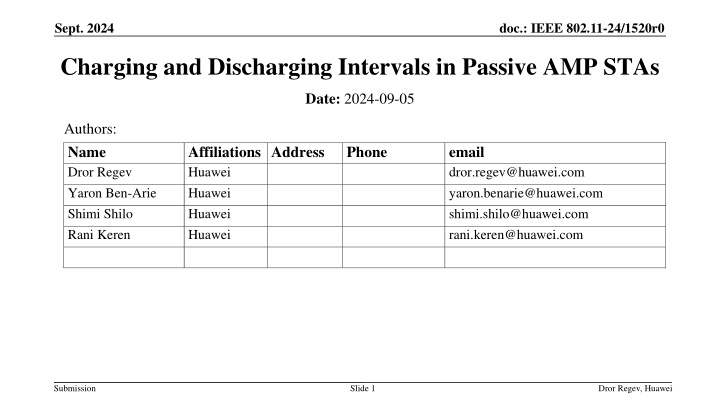

![Prevention and Combating of Hate Crimes and Hate Speech Bill [B.9B.2018]](/thumb/60513/prevention-and-combating-of-hate-crimes-and-hate-speech-bill-b-9b-2018.jpg)

